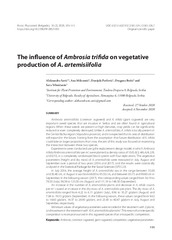Приказ основних података о документу
The influence of Ambrosia trifida on vegetative production of A. artemisiifolia
| dc.creator | Savić, Aleksandra | |
| dc.creator | Pavlović, Danijela | |
| dc.creator | Božić, Dragana | |
| dc.creator | Vrbničanin, Sava | |
| dc.creator | Mileusnić, Ana | |
| dc.date.accessioned | 2023-08-18T11:16:06Z | |
| dc.date.available | 2023-08-18T11:16:06Z | |
| dc.date.issued | 2020 | |
| dc.identifier.issn | 1820-3949 | |
| dc.identifier.issn | 2406-1026 | |
| dc.identifier.uri | https://plantarum.izbis.bg.ac.rs/handle/123456789/839 | |
| dc.description.abstract | Ambrosia artemisiifolia (common ragweed) and A. trifida (giant ragweed) are very important weed species that are invasive in Serbia and are often found in agricultural regions. When these weeds are present at high densities, crop yields can be significantly reduced or even completely destroyed. Unlike A. artemisiifolia, A. trifida is locally present in the Central Bačka region (Vojvodina province), and it is expected that its area of distribution will expand in the future. Starting from the assumption that future distribution of A. trifida could take on larger proportions than now, the aim of this study was focused on examining the interaction between these two species. Experiments were conducted using the replacement design model, in which Ambrosia trifida/Ambrosia artemisiifolia per m2, were planted as density ratios of 10/0; 8/2; 4/6; 6/4; 2/8, and 0/10, in a completely randomized block system with four replications. The vegetative parameters (height and dry mass) of A. artemisiifolia were measured in July, August and September over a period of two years (2016 and 2017), and the results were statistically analysed in the Statistical Package for the Social Sciences (SPSS 23). In July 2016, the average height of A. artemisiifolia was in the range between 35.00 and 50.40 cm, in August it was from 68.00 to 95.50 cm, and between 83.75 and 99.80 cm in September. In the following season (2017), the corresponding values ranged from 56.19 to 78.50 (July), 98.38 to 125.50 cm (August) and 111.19 to 148.50 (September). An increase in the number of A. artemisiifolia plants and decrease in A. trifida counts per m2 caused an increase in the dry mass of A. artemisiifolia per plant. The dry mass of A. artemisiifolia ranged from 4.22 to 6.11 g/plant (July), 8.96 to 10.27 g/plant (August) and 7.04 to 19.53 g/plant (September). In the following season, these values ranged from 9.62 to 14.60 g/plant, 14.37 to 28.90 g/plant, and 23.43 to 40.47 g/plant in July, August and September, respectively. Minimum values of vegetative parameters were recorded in the treatment with 2 plants, and maximum in the treatment with 10 A. artemisiifolia plants/m2. This means that interspecific competition is more pronounced in this ragweed species than intraspecific competition. | sr |
| dc.language.iso | en | sr |
| dc.publisher | Institute of Pesticides and Environmental Protection, Belgrade & Plant Protection Society of Serbia, Belgrade | sr |
| dc.relation | info:eu-repo/grantAgreement/MESTD/Integrated and Interdisciplinary Research (IIR or III)/46008/RS// | sr |
| dc.relation | info:eu-repo/grantAgreement/MESTD/inst-2020/200116/RS// | sr |
| dc.rights | openAccess | sr |
| dc.rights.uri | https://creativecommons.org/licenses/by-sa/4.0/ | |
| dc.source | Pesticides and Phytomedicine/Pesticidi i fitomedicina | sr |
| dc.subject | Ambrosia | sr |
| dc.subject | common ragweed | sr |
| dc.subject | giant ragweed | sr |
| dc.subject | competition | sr |
| dc.subject | vegetative parameters | sr |
| dc.title | The influence of Ambrosia trifida on vegetative production of A. artemisiifolia | sr |
| dc.type | article | sr |
| dc.rights.license | BY-SA | sr |
| dc.citation.epage | 115 | |
| dc.citation.issue | 2 | |
| dc.citation.rank | M24 | |
| dc.citation.spage | 105 | |
| dc.citation.volume | 35 | |
| dc.type.version | publishedVersion | sr |
| dc.identifier.doi | 10.2298/PIF2002105S | |
| dc.identifier.fulltext | http://plantarum.izbis.bg.ac.rs/bitstream/id/2715/bitstream_2715.pdf |


